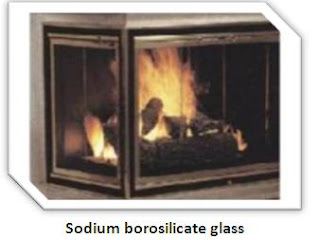Glass:
Glass is an engineering material which is an amorphous (no-crystalline)
solid material. Glasses are typically and optically transparent.
Glass is composed of about 75% slica (SiO2)
Puls Na2), CaO, and several minor additives.
Type
of glasses:
1.
Fused
silica glass, vitreous silica glass: mainly silica, has very low thermal
expansion, is very hard and resists high temperature (1000-1500 c). it is also
the most resistant a weathering ( alkali ions leaching out of the glass while staining
it). It is used for high temperature applications such as furnace tubes melting
crucibles.
2.
Soda lime
silica glass window glass: Silica 72%+ sodium oxide (Na2O) 14.2% + Magnesia
(MgO)2.5% + Lime (CaO) 10.0% + akynuba
(Al2O3) 0.6%. Is transparent easily formed and most suitable for window glass. It
has a high thermal expansion and poor resistance to heat (500- 600 c). used for
windows, containers, light bulbs, tableware.
3.
Sodium borosilicate
glass, pyrex: Silica 81%+ boric oxide (B2O3) 12%Soda (Na2O) 4.5% + alumina
(al203) 2.0% stands heat expansion much better than window glass. Used for
chemical glassware, cooking glass, car head lamps, etc
4.
Lead
oxide glass, crystal glass: silica 59%+ soda (Na2O) 2.O%+ lead oxide
(PbO)25%+ potassium oxide (K2O) 12% + Alumina 0.4% + ZnO 1.5% has a high
refractive index, making the look of glassware more brilliant (crystal glass).
It also has a high elasticity, making glassware ring. It is also more workable
in the factory, but cannot stand heating very well.





No comments:
Post a Comment